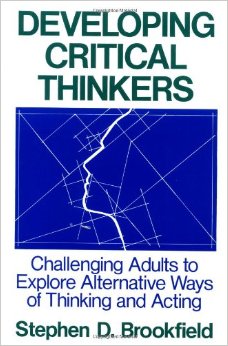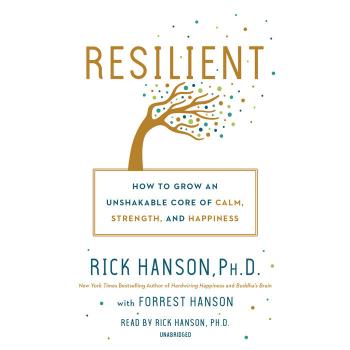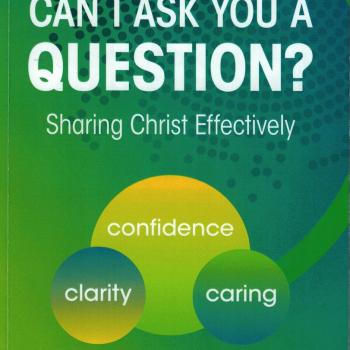Developing Critical Thinkers by Stephen D. Brookfield
Critical thinking is defined in this book is composed of two processes: identifying and challenging assumptions, and then imagining and exploring alternatives. When I think critically, my perceived truth, or my understanding of absolute truth, changes. By questioning what I have always understood to be true, I can come to a better position, or find a better solution to a problem that I have encountered. This is the premise of the book. Not only should I learn to think differently about what I have learned, but I should learn to explore new ways of solving problems.
Part One (chapter one through four) spends time defining the concept of critical thinking, and then presents the benefits of critical thinking. Critical thinking means that a person does not blindly accept everything they have learned. A critical thinker learns to understand what is being told to them, and then broadens their learning experience beyond just their immediate environment. A critical thinker considers other alternatives in their world than the ones they have always been given. For real positive change to happen, critical thinking is necessary.
This book teaches that people can learn to be facilitators of critical thinking. A facilitator (or helper) guides people through the critical thinking process. While the concepts seem to be useful for professional counselors, I saw immediate application for leaders, pastors and teachers. The principles used to facilitate critical thinking are very similar to the principles of good leadership.
Part Two (chapters five, six, and seven) deals with practical approaches for developing critical thinkers. The book shares in chapter six how to help other people examine the assumptions underlying their thoughts and actions. The author teaches how to ask questions in a way that allow a person to challenge what they have always done. For example, critical questioning is a way in which someone learns to “think back” to an event, and then re-evaluate the event. In role-playing how they could have done something differently, a person learns to think critically, and improve on their assumptions. This will lead to another form of critical thinking – developing alternative ways of thinking.
The theme of chapter seven is to “think outside of the box.” The chapter describes changing the frameworks of understanding through which a person makes sense of the world. Paradigm is another way of saying the “box” in which we think. The challenge of helpers (mentors, pastors, counselors, and teachers) is to help people think outside the box. The author contends that in the twenty-first century, people will learn to be process persons. People now understand that change is the one certain element in life. I was amazed at this prediction. For I agree with the author that post-modern people are process people, and that they handle change easier. So the role of a pastor would have to change from one of expert to facilitator. The new leadership role of a pastor would be to help facilitate these people to think critically. Thinking outside of the box would require thinking creatively.
The chapters present some very good exercises that help people think creatively. Brainstorming (probably the most famous and most common), envisioning alternative futures, developing preferred scenarios, futures invention, and esthetic triggers (left-brain activities) all help people to think creatively, and thus critically. The application for the church I found amazing. For I believe that we do not allow our members to think creatively. Take for example, esthetic triggers. We don’t create these activities. We are unfamiliar with creating poetry, drama, fantasy, photography, theatre or songwriting in the church. We may use these resources, such as songs and drama, but we use them very little. We primarily still use the right-brain forms for worship. We listen to a sermon that is didactically presented. We absorb, but we do not participate. So the idea of thinking creatively struck me as an opportunity for the church.
Part Three (chapters eight through twelve) addresses how people can learn to think critically in different arenas of life. This section of the book applies the principle of critical thinking to the workplace, the political arena, the media, and in personal relationships.
With respect to the media, viewers are encouraged to have skepticism for what they see on the television screen. This I think applies just as well to not only secular media, but also the religious media. The critical thinker needs to be able to interpret political spin, or any other type of spin that is made from a media source. The most important skill in learning from the media is the ability to decode what was encoded to a viewer in the media. The author suggests that a person or group of people can use the VCR as a tool to do this. A group can take broadcasts and programs, and by reviewing the images and the news, they can deconstruct what was said. The advents of cable television, the Internet and YouTube have made this task even simpler. The prediction of being able to “talk back” to the television screen in chapter ten was quite prophetic. This prediction of internet forums, blogs, and social networks as a form of media literacy was quite profound. Thinking critically has become possible and been made easier with these new tools.
Chapter eleven describes ways in which learning can be encouraged through personal relationships. It is in this chapter that I found the most relevant information for change in the church. Specifically, I agreed with the author that friendships will be the key to overcoming difficulties in marriage, family, and life in general. Fostering friendships as relaxed relationships and a haven for people can be very beneficial.
Chapter twelve describes the role of the facilitator as a helper for learning. I took this form of leadership would make small groups in the church the most effective. There is much that the church can learn from this idea. Instead of having a group of people adheres to an expert teacher for learning, the facilitator would be there to help the group learn. The suggestions in this chapter and in the epilogue could be very valuable for a small group ministry in the church. I agree wholeheartedly with this approach.
This book would benefit many churches – especially church leaders, Sunday School teachers, and small group leaders. However, the greatest hurdle in using the book is in first understanding the book. The problem is that a person must first have been exposed to critical thinking in order to understand the concepts in the book. Otherwise, a person will discard the book after reading the title.













